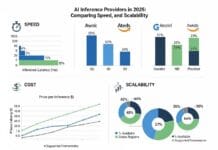Because of AI, or artificial intelligence, social media platforms have changed dramatically over the past number of years to complex ecosystems.
Entertainment trends and communication dynamics that billions of people see as soon as they open their app are determined by algorithms.
There is a definite shift towards personalization by these systems on a scale that has never been seen before.
With no human intervention, communities thrive, brands gain traction, and creators rise, all determined by AI.
Understanding this transformation matters for individuals, creators, and organizations seeking visibility.
AI determines which videos surface on a For You Page, which posts appear in a user’s recommended feed, and how long content remains discoverable.
Attempts to buy TikTok followers or buy YouTube views are detected and filtered by artificial engagement patterns, affecting reach in general.
Having insights into AI-driven visibility is no longer optional because of the quantity of content competing for attention.
If you want to thrive in the digital world, you essentially need AI.
1. The AI Behind Modern Social Media Algorithms
In order to process vast amounts of data, modern recommendation systems are built on advanced machine-learning architectures designed for that purpose.
Intricate ranking models that constantly update based on user behavior are used for major platforms that include X, Facebook, TikTok, and YouTube.
These AI generated social media algorithms reorganize feeds in real time to produce what each user is statistically most likely to enjoy, and they evaluate each and every individual’s interaction with profiles, posts, and videos.
There are different signals that are analyzed by the algorithms, for example, the speed at which a user scrolls past certain posts, the watch time, hover duration, comments, and, of course, likes.
The actions from the user help AI understand preferences, attention, and subtle patterns.
There are many other factors that AI assesses, for example, if there is contextual alignment with a user’s interests, engagement authenticity, and completion rates.
Instead of showing all content in order, platforms prioritize personalized experiences powered by AI-curated relevance.
Long before a user even starts searching for what they find appealing, predictive modeling allows a platform to anticipate it.
This is why creators must understand how these algorithms think and what the foundation is of today’s personalization mechanisms.
2. Key Factors That Influence Content Reach Today
A variety of signals influence how widely content spreads in today’s AI-driven environment.
Engagement velocity, which refers to how quickly a post accumulates shares, comments, likes, and watch time after being published, is the most important way content is spread.
What prompts algorithms to push content to a wider audience is fast, early interaction signaling relevance and quality.
Travel, gaming, financial advice, skincare, etc. Are matched with users who have shown interest in similar themes by platforms that categorize posts into topic clusters.
Micro-behaviors, for example, searches, time spent on topics, or previous engagement histories, are used by AI to build profile bases.
Different ranking signals are prioritized by different platforms.
In other words, while keyword matching and metadata optimization are particularly important on YouTube, video completion rate influences TikTok and Reels distribution.
Whether a certain piece of content is to be shown to new audiences or kept within a limited pool is determined by signals received by AI.
Low-quality, misleading, and repetitive content is also suppressed by AI.
Attempts to buy YouTube views to manipulate performance, which is associated with artificial engagement, are flagged.
Trained machine-learning models can detect irregular patterns and are able to detect behaviors associated with artificial engagement, for example, in attempts to buy YouTube views to manipulate performance.
Activity that appears forced or inorganic can easily be detected by this adept AI system.
3. The Rise of Authenticity and Human-like Interaction Signals
Authentic human behavior is rewarded by algorithms that have become more and more sophisticated, as opposed to artificial boosts.
Genuine conversations, thoughtful comments, and natural growth patterns correlate strongly with long-term user satisfaction, and platforms are fully aware of this.
With the result that meaningful interactions and comments that reflect real engagement, shares that show genuine interest, and dialogue that fosters community are greatly emphasized by AI.
AI systems also detect spammy engagement patterns to maintain integrity on platforms.
Signals that are different from normal user behavior are often produced, for example, when attempting to buy TikTok followers or mass-automated likes or by using click farms.
Unnatural growth spikes, repetitive engagement from low-credibility accounts, or interactions that lack context are included in these anomalies.
Visibility of content that relies on such tactics is reduced through AI that quickly identifies these patterns.
Patterns that mimic real human activity, steady increases in visibility, natural comment styles, diverse engagement sources, and consistent user interest are highly valued by platforms.
Algorithms reward creators who cultivate community through relatable storytelling, conversation-driven posts, and authentic interactions.
4. Ethical AI: Balancing Visibility, Safety, and User Well-Being
When it comes to creating safer digital spaces, AI plays a critical role, it’s not only about amplifying popular content.
To detect misleading, harmful, or inappropriate content before it spreads, platforms make use of automated systems.
These systems are not perfect, but they are able to recognize misinformation, violence, manipulation, and hate speech.
To prevent the mass distribution of dangerous materials, AI is playing a major role.
Even though this is helpful, it does not resolve ethical challenges.
Inherent human biases can be contained in the user-generated data that AI models learn from, which is a problem.
Outcomes can sometimes be biased or unfair and can cause unintentional suppression of certain voices or unfair visibility.
Generally speaking, platforms are investing in transparent ranking updates, fairness audits, and diverse training datasets to mitigate these types of issues.
The idea is for freedom of expression and user safety to be balanced.
Over-filtering of valuable conversations is needed, and responsibility has to be moderated by platforms.
The push toward ethical and transparent systems will shape future regulatory debates and platform policies as AI becomes more and more advanced.
5. Future Trends: Where AI-Driven Social Media Is Heading
Social media will be made even more dynamic and predictive with the next generation of AI systems.
AI models that are able to estimate how well a post will perform before it is even published are emerging. In other words, a predictive content performance scoring system.
When, how, and what posts creators upload on platforms are already influenced by these systems.
It is expected that these types of AI-generated content assistance will keep expanding.
It will become a standard feature for tools to help creators craft captions, generate video scripts, and analyze audience behavior.
Algorithms can create niche content ecosystems tailored to specific interests, which in turn creates micro-communities.
Creators can easily gain traction in specialized fields because of this.
Platforms have realized greater transparency is needed, and they are moving towards it.
This will give creators clearer guidance, and they will gain more insight into ranking factors, content scoring, and algorithmic preferences, providing clearer guidance.
- How Creators Can Adapt to an AI-First Social Media Environment
Creators must focus on producing content aligned with viewer intent to succeed in an AI-driven environment.
It’s important for them to know exactly what questions people have, what they search for, and what types of media they prefer.
To help creators identify trending formats, optimal posting times, and audience preferences, data insights such as analytics dashboards are available.
Another important way is to experiment.
Creators can reach, diversify, and maintain algorithmic favor through short-term videos, interactive storytelling, live sessions, and multi-format posting.
It is crucial to remain adaptable.
- Conclusion
Nearly every aspect of social media visibility is shaped by AI.
These systems define what creators and audiences experience daily by detecting authentic engagement to rank content based on quality and relevance.
Understanding algorithms and interpreting signals have become more important than frequent posting.
If you as a creator embrace transparency, adaptability, and authenticity, you’ll thrive during the reshaping of AI.





